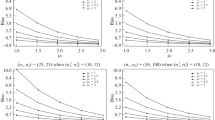Abstract
The correlation coefficient of non-normal variables is expressed as a function of the correlation coefficient of normal variables using piece-wise linear approximation of each univariate transform of normal to anything, and the second order moments of a multiply truncated bivariate normal distribution. For the inverse problem, an algorithm iterates this analytic function in order to assign a normal correlation coefficient to two non-normal variables. The algorithm is applied for the generation of randomized bivariate samples with given correlation coefficient and marginal distributions and used in a randomization test for bivariate nonlinearity. The test correctly does not reject the null hypothesis of linear correlation if the nonlinearity is plausible and due to the sample transform alone.
Similar content being viewed by others
References
Birnbaum ZW, Meyer PL (1953) On the effect of truncation in some or all co-ordinates of a multinormal population. J Indian Soc Agric Stat 5: 17–28
Bhatt NM, Dave PH (1964) A note on the correlation between polynomial transformations of normal variates. J Indian Stat Assoc 2: 177–181
Box GEP, Cox DR (1964) An analysis of transformations. J R Stat Soc Ser B 42: 71–78
Cario MC, Nelson BL (1996) Autoregressive to anything: time-series input processes for simulation. Oper Res Lett 19: 51–58
Cario MC, Nelson BL (1997) Modeling and generating random vectors with arbitrary marginal distributions and correlation matrix. Technical report, Department of Industrial Engineering and Management Sciences, Northwestern University, Evanston, IL
Chen H (2001) Initialization for NORTA: generation of random vectors with specified marginals and correlations. INFORMS J Comput 13(4): 312–331
Cohen AC (1991) Truncated and censored samples: theory and applications, statistics: textbooks and monographs. Marcel Dekker, New York
Gajjar AV, Subrahmaniam K (1978) On the sample correlation coefficient in the truncated bivariate normal population. Commun Stat B Simul Comput 7: 455–477
Hawkins DM (1994) Fitting monotonic polynomials to data. Comput Stat 9: 233–247
Hutchinson TP, Lai CD (1990) Continuous bivariate distributions emphasising applications. Rumsby Scientific Publishing, Adelaide
Johnson N, Kotz S (1970) Distributions in statistics, continuous univariate distributions. Houghton Mifflin Company, Boston
Kendall MG, Stuart A (1979) The advanced theory of statistics. Volume 2: inference and relationship. Griffin, London
Kotz S, Balakrishnan N, Johnson NL (2000) Continuous multivariate distributions: volume 1: models and applications, 2nd edn. Wiley series in probability and statistics. Wiley, New York
Kovner JL, Patil SA (1973) On the moments of the doubly truncated bivariate normal population with application to ratio estimate. J Indian Soc Agric Stat 25: 131–140
Kugiumtzis D (2002a) Statically transformed autoregressive process and surrogate data test for nonlinearity. Phys Rev E 66: 025, 201
Kugiumtzis D (2002b) Surrogate data test on time series. In: Soofi A, Cao L (eds) Modelling and forecasting financial data. Techniques of nonlinear dynamics, chap. 12. Kluwer, London, pp 267–282
Li ST, Hammond JL (1975) Generation of pseudorandom numbers with specified univariate distributions and correlation coefficients. IEEE Trans Syst Man Cyber 5: 557–561
Muthén B (1990) Moments of the censored and truncated bivariate normal distribution. Br J Math Stat Psychol 43: 131–143
Regier MH, Hamdan MA (1971) Correlation in a bivariate normal distribution with truncation in both variables. Aust J Stat 13(2): 77–82
Rosenbaum S (1961) Moments of a truncated bivariate normal distribution. J R Stat Soc Ser B 23: 405–408
Schneider H (1986) Truncated and censored samples from normal populations, statistics: textbooks and monographs. Marcel Dekker, New York
Schreiber T, Schmitz A (2000) Surrogate time series. Physica D 142(3–4): 346–382
Stanhope S (2005) Case studies in multi-variate-to-anything transforms for partially specified random vector generation. Insur Math Econ 37: 68–79
Tallis GM (1961) The moment generating function of the truncated multi-normal distribution. J R Stat Soc Ser B 23: 223–229
Theiler J, Eubank S, Longtin A, Galdrikian B (1992) Testing for nonlinearity in time series: the method of surrogate data. Physica D 58: 77–94
Geest PAG (1998) An algorithm to generate samples of multi-variate distributions with correlated marginals. Comput Stat Data Anal 27: 271–289
Wang Q, Shen Y, Zhang JQ (2005) A nonlinear correlation measure for multivariate data set. Physica D 200: 287–295
Weiler H (1959) Means and standard deviations of a truncated normal bivariate distribution. Aust J Stat 1: 73–81
Yu GH, Huang CC (2001) A distribution free plotting position. Stoch Environ Res Risk Assess 15: 462–476
Author information
Authors and Affiliations
Corresponding author
Rights and permissions
About this article
Cite this article
Kugiumtzis, D., Bora-Senta, E. Normal correlation coefficient of non-normal variables using piece-wise linear approximation. Comput Stat 25, 645–662 (2010). https://doi.org/10.1007/s00180-010-0195-3
Received:
Accepted:
Published:
Issue Date:
DOI: https://doi.org/10.1007/s00180-010-0195-3




